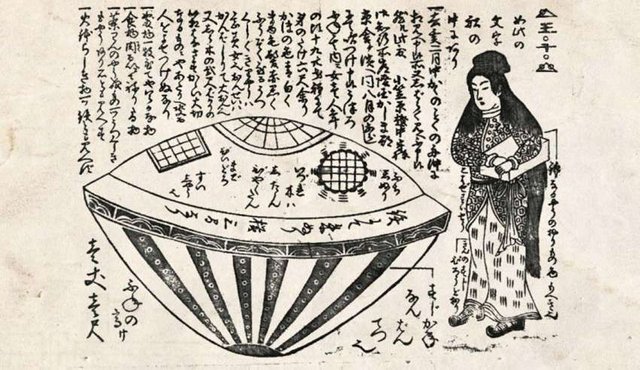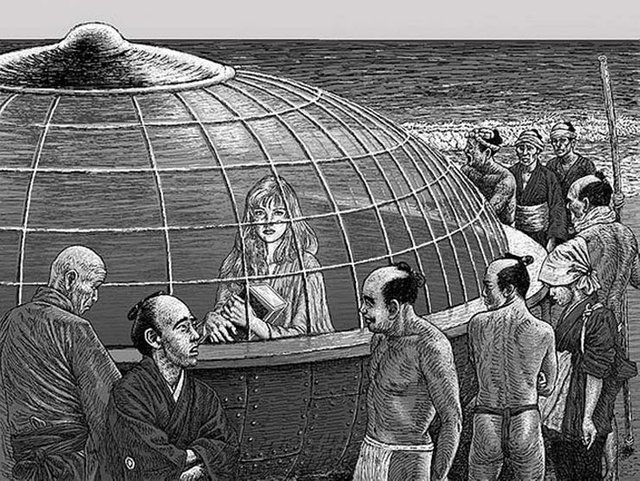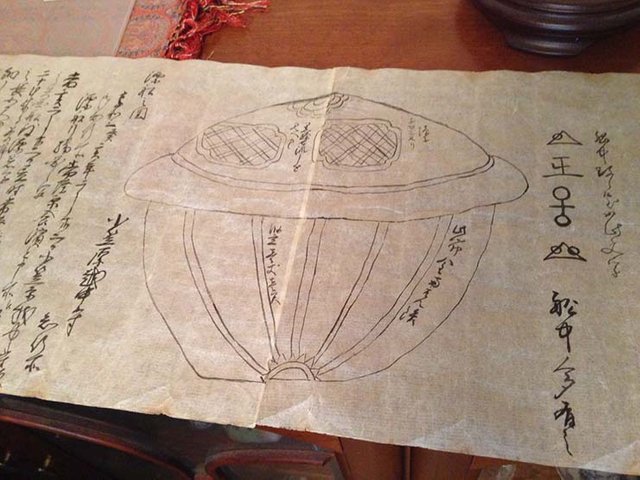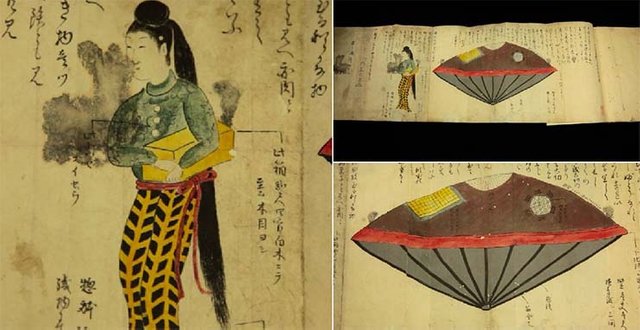Utsuro-bune: The woman extraterrestrial in the Seas of Japan, that came out of nowhere

The culture of Asia possesses unfathomable mysteries that have lasted for centuries and are really exciting for the Western Hemisphere. There are legends that have kept their validity for hundreds of years. and is that there is a case that by its context is one of the most amazing, this is the Utsuro-Bune, and is that surprisingly, it deals with artifacts that are located out of place and time, and also includes contact with extraterrestrial entities.
This event is set in 1803, in the province of Hitachi, where a group of Japanese fishermen, witnessed a meeting with casual with a Utsuro-bune, whose meaning is (nave concave), on the banks of the beaches of Haratonohama. The group was surprised to catch the strange craft, with decorations and cover of a strange amount of ornaments. The description given by the fishermen as soon as their volumes were about 4 meter high and 6 meters wide.
The material with which it was made, apparently was redwood, a type of tree and as perimeter ornament, bronze plates, on its lower side and a series of transparent windows in the upper half. The descriptions point out that the Utsuro-Bune had the appearance of a bowl of incense, and after being dragged to the shore, the fishermen were surprised by what they could see inside.

They could see the daring of the windows, strange texts, written in a totally unknown language with characters never seen. Likewise, there were clothes and food, and a strange woman of outward appearance. His age oscillated between 18 and 20 years, with pale complexion, and an intense red hair, with artificial extensions. His robes consisted of an elegant cloth. The language of the woman was strange, because of which the fishermen could not have communication with her, however the woman had a kind treatment. It carried a box of square shape, which kept away from the fishermen, despite the fishermen's motion to see its contents.
The encounter lasted a short time since the fishermen, had by customs not to get involved with foreigners. And they returned the woman to the Utsuro-Bune, placing the artifact again in the sea.

They had no knowledge of the woman's origin, nor who she was. They also did not understand the reason for their solitary voyage, but nevertheless the story of an old man in the village as a speculation, that the woman could be a princess of an unknown country that was banished for having betrayed her husband. For having had contact with other men. That because of the beautiful and attractive figure, the people loved her, and that even though she could have been executed, her husband had mercy, Desterrándola and putting her to his fate.
This would be one of the existing versions. But there are 3 versions of the story, and they exist in ancient text:
• Toen Shōsetsu, written by Kyokutei Bakin of 1825
• Hyōryū 紀州 unknown author of 1835
• Ume-no-Chiri, of Nagahashi Matajirō written in 1844

Encounter with an unknown individual from another world.
The history and its relatively modern scheme, coupled with its great level of detail, confronts us with the possibility that this fact has actually happened. That type of boat was very common at that time, although the narrated in the story was really totally atypical. This characteristic could be explained, because the boat was of foreign origin, this could be explained because it was made to have strength on a voyage on the high seas, instead of traversing lakes or turbulent rivers. So the legend of Utsuro-Bune seems to have a meeting between different civilizations. Although even with the details described, there is difficulty in knowing whether it is an allegory or a real story.
Experts on the subject indicate that according to the drawings and graphics of the boat, it could be a OSNI (unidentified submarine object) and that women's clothing and appearance would be similar to those of aliens. Also other experts say that there is a certain coincidence between the drawings and symbols, with those of the encounter of the UFO incident of Rendlesham Forest, in England at the end of 1980.
An alternative reality?
Although there is another possibility, and is that the legend of Utsuro-Bune is another case similar to the man of Taured, which curiously also occurred in Japan. As we published in Esoteric and paranormal world, in the year 1954, a mysterious man from Europe presented his passport to the customs agents of a Japanese airport. The document was from a completely unknown country, but it seemed to be authentic. According to his passport, the man was from a country called Taured. He even carried the legal currency of several European countries in his wallet.
According to the man's version, he had travelled to Japan for business, and it was not the first time. His company was a subsidiary of an international conglomerate. But the most surprising thing was that he had a driver's license issued by his country, Taured, plus an international driver's license, completely valid, and a checkbook from an unknown bank. However, after being detained and taken to a hotel, where only one could leave for an access, the man disappeared as if it had never existed.
As we can see, this is history is similar to that of Utsuro-bune, so it could be a new case of an alternative reality, and curiously also in Japan. If give for good this theory, then leaves us many more questions than answers: What connection is there between Japan and the alternative realities or parallel universes? "
"Is it a simple legend?
But for many scholars the story of Utsuro-Bune seems to be an amalgam of several much older cultural legends from Japan and China. They claim that the elements of history can be found in any number of other unrelated legends, which does not automatically exclude Utsuro-Bune as a truthful account of a real event.
In 1997, Dr. Kazuo Tanaka, a professor at the University of Tokyo, studied the legend of Utsuro-Bune and relied on the work previously done by the Japanese historian Kunio Yanagita in 1925 and 1962. Tanaka concluded that the story was nothing more than a relatively modern narrative of an ancient allegory. He affirmed that the places quoted, Haratonohama and Harayadori, are completely fictitious, and that certain elements of the history are almost archetypal of the Japanese attitudes towards the foreigners in the antiquity.
Is Utsuro-Bune a history of encounters with extraterrestrials and advanced technology? Is it a description of a real event, a happening that entails the intrigue and mystery of strange lands and cultures? Really